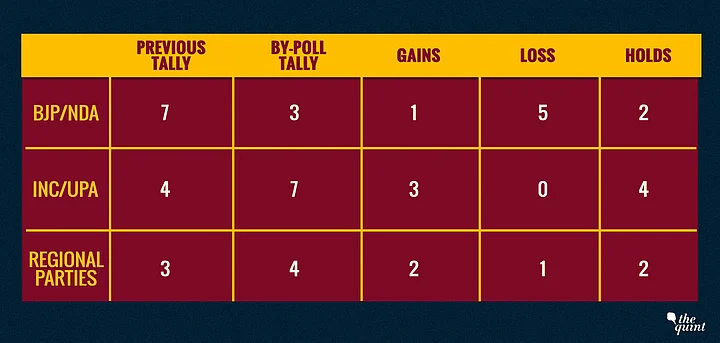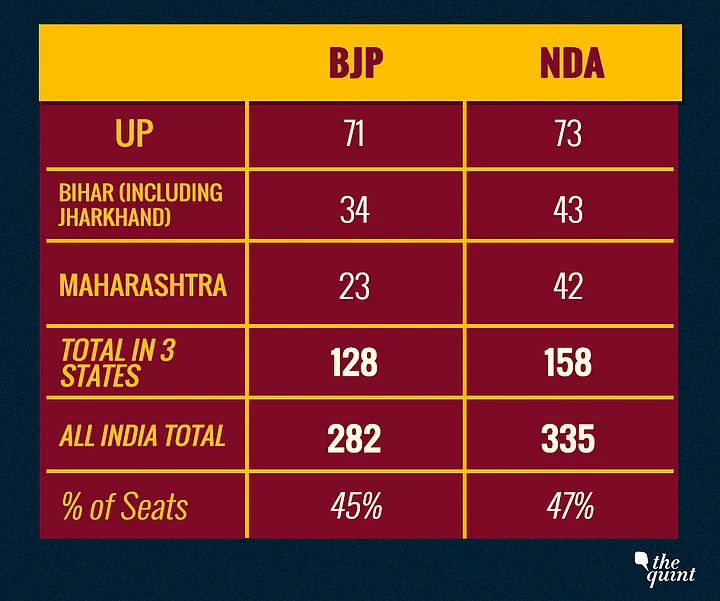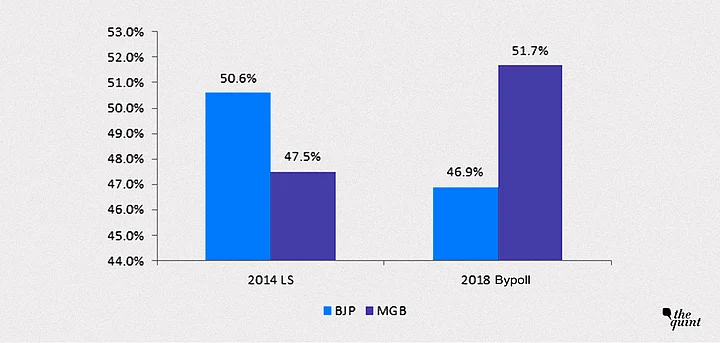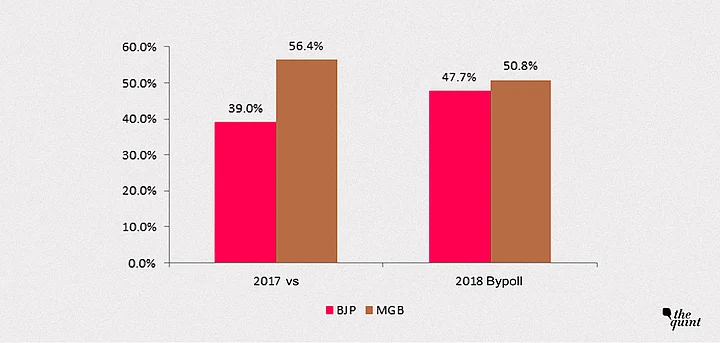
The above table depicts the bypoll results declared for 14 seats (4 Lok Sabha and 10 Vidhan Sabha) held across 10 states, namely UP, Bihar, Maharashtra, Jharkhand, Punjab, Uttarakhand, Meghalaya, Nagaland, West Bengal and Kerala. These 10 states account for almost half of the Lok Sabha strength. BJP alone won 128 seats of its 282 tally of Lok Sabha 2014 (45 percent) from only three of the above states.

Summary of Bypoll Results
- BJP/NDA’s tally has been reduced by half
- INC/UPA’s tally has nearly doubled
- Regional parties and UPA have held onto their strength
- Of the 14 seats, 8 seats were held by the previous parties
- Of the 6 seats which changed hands, BJP lost the maximum (5)
Mahagathbandhan Poses Serious Threat to BJP in UP-Bihar
The string of losses for BJP continued in Uttar Pradesh. After having lost Gorakhpur and Phulpur to a united opposition just a couple of months ago, BJP lost the Kairana Lok Sabha seat and Noorpur Vidhan Sabha seat to a united opposition’s (mahagathbandhan) candidates.
BJP lost the Kairana seat to the RLD candidate supported by SP, BSP and Congress by a margin of 44,618 votes.
The loss is even more astounding given the fact that BJP had won the seat in 2014 by a whopping margin of 2.36 lakh votes and would have even won if the mahagathbandhan (MGB) parties had contested together. In the bypoll, while BJP’s vote share declined by 3.7 percent, MGB gained a vote share of 4.2 percent.

In Noorpur, the BJP candidate lost to the SP candidate backed by the opposition by a margin of 5,662 votes. In the state elections held last year, BJP had won the seat by a margin of over 12,000 votes. However, BJP benefited from a fractured opposition in 2017 state elections as the graph shows.
If MGB parties had contested together in 2017, their vote share would have been much higher at 56.4 percent and BJP would not have managed to win the seat. In the bypoll, while BJP managed to increase its vote share by 8.7 percent, the sheer power of the arithmetic of MGB helped it to sail through despite losing 5.6 percent vote share.

Anti-Incumbency Might Work Against Nitish in Bihar
The index of chemistry of the opposition is very high at 90 percent (vote share in bypoll divided by vote share in state polls had they contested together, 50.8 percent divided by 56.4 percent).
This indicates that SP, BSP and RLD have been able to transfer their votes to each other candidates’ with minimum leakages (-10 percent). This is a very good index of chemistry, implying the vote banks are in harmony with each other. MGB in Bihar which trounced Modi in 2015, had a similarly high index at 93 percent. Generally, anything above 85 percent is very good.
MGB in UP has both the arithmetic and the chemistry as of now. It has also displayed the ability to reclaim its vote segments of Jats and Dalits which had veered towards the BJP in 2014 and 2017.
In 2014, NDA secured 43.6 percent and MGB (if it had contested together) 50.5 percent. Even at 86-87 percent, the index of chemistry and 12-13 percent translation loss, it could pose a serious challenge to BJP in 2019.
In Bihar’s Jokihat assembly seat, RJD defeated JDU by a huge margin of 41,225 votes. Both parties had put up minority community candidates. The votes received by the JDU candidate (40,015) were even lower than the margin — such was the magnitude of victory.
The seat was held by JDU since 2005. After Nitish re-joined the NDA, parting ways with Lalu, this is the 3rd bypoll which RJD has won. It spells warning bells for BJP in Bihar where it along with allies won 31/40 seats in 2014.
Nitish Kumar, who has been chief minister for over 15 years, is facing natural anti-incumbency, especially with Tejaswi Yadav posing a serious challenge.
Nitish used to enjoy a decent amount of minority support but he seems to be losing control over that support base since he joined hands with Modi. In Jharkhand, regional satrap Shibu Soren’s JMM, which is with UPA, is still going strong as it held onto the 2 seats of Silli and Gomia it had won in 2014 state polls.
A MGB in the Making in Maharashtra
BJP managed to hold onto the Palghar seat in a bitter contest with its estranged ally Shiv Sena, which finished as runner-up. Uddhav Thackeray even alleged irregularities and requested EC to recount votes. While the BJP candidate polled 32 percent, the Shiv Sena candidate recorded 29 percent vote share.
BJP benefited from a split of votes. If Congress had not contested the seat, and reciprocated Shiv Sena’s gesture of not putting up a candidate in Bhandara-Gondiya, BJP would have lost the seat by 18,000 votes.
NCP snatched the Bhandara seat from BJP by 48,000 votes helped by Shiv Sena support, as it didn't put up a candidate. BJP had won the seat in 2014 by a big margin of 1.49 lakh votes. BJP lost vote shares in both seats compared to the last elections.

BJP Needs to Win Back Its Allies
The Shiv Sena and BJP relationship have hit rock bottom, and the bypoll results will further increase the distance between the two. Shiv Sena is unhappy with BJP and the two allies have been bickering in public. If the three parties – INC, Shiv Sena and NCP – get into some sort of understanding like in Bhandara, the sheer arithmetic of it would damage BJP severely.
INC+SHS+NCP vote share in 2014 at 55.2 percent is double that of BJP’s at 27.6 percent. BJP would hope Shiv Sena contests independently (as it has announced), making it a three-way fight. However, that takes out 18 seats of the Shiv Sena from the NDA tally of 2014, and that’s huge.
UP, Bihar and Maharashtra hold the key to government formation in 2019. Opposition unity is sealed in UP and Bihar. If Shiv Sena switches sides, then even Maharashtra will see one-to-one contests.
TMC retained the lone seat in West Bengal (Maheshtala), while CPI(M) retained the Chennagur seat in Kerala. SP and RLD made a dent in the BJP stronghold of UP as discussed above.
Going purely by the bypoll trends, BJP could face reversals in the three big states of UP, Bihar and MH where it bagged 45 percent of its seats in 2014. Merely wishing away the results as a one-off and blaming it on local factors won’t help the party. It needs to acknowledge the serious threat to its bid for power in 2019.
The silver lining for BJP is that it has emerged as the second largest party in West Bengal ahead of CPI(M). BJP's ally NDPP won the Nagaland parliamentary seat consolidating NDA's position in the North East. However, Mamata Banerjee is still the strongest by far in Bengal, and North East is a small territory and has much fewer seats for it to compensate for the losses. It needs to make a big dent in Odisha and repair ties with the Shiv Sena in Maharashtra.
2019: The Bigger Picture
Modi has to realise that he will need the support of allies in 2019 and can't let them all leave like TDP. Modi-Shah’s arm twisting tactics and high-handedness won’t work anymore. They have to change their style of functioning. It's time for Modi to adopt a Vajpayee-like approach and expand the BJP’s footprint by adding new allies.
In UP, it all boils down to a seat-by-seat contest. It will be a DMY (Dalits + Muslims + Yadavs) versus UCOBC (Upper Caste + Other Backward Caste) contest. What makes it interesting is that both these anchor vote blocks of UPA and NDA respectively account for 50 percent of the population each.
One thing favouring the BJP is that the opposition has played its cards too soon, leaving ample time for the party to formulate a strategy to counter the MGB before 2019.
The game is still on. While the opposition is hoping that both the arithmetic and chemistry will work in its favour, the BJP is banking on ‘sahi niyat’ (right intentions) and Modi magic. Brace yourself for a roller coaster ride.
(Amitabh Tiwari is an ex corporate and investment banker turned political consultant and commentator. He is co-author of ‘Battle of Bihar’ and can be reached @politicalbaaba. This is an opinion piece and the views expressed above are the author’s own. The Quint neither endorses nor is responsible for them.)
(At The Quint, we are answerable only to our audience. Play an active role in shaping our journalism by becoming a member. Because the truth is worth it.)
